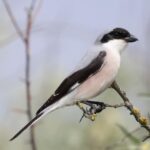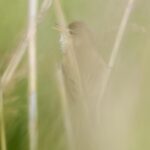Day 1 of a three day long weekend of Autumn Tours today. It was a glorious day to be out – sunny, blue skies, and warm after the sun saw off the typical cool of an autumn morning. Not great perhaps for bringing in new migrants, but a lovely day to catch up with those already here.
Our first destination was Wells Woods. As we walked across the car park, we could hear Pink-footed Geese calling, their distinctive high-pitched yelping, and we looked up to see a small skein of about thirty flying west. A sign that autumn is definitely here, with geese arriving for the winter!
There were Long-tailed Tits calling from the pines as we walked past the boating lake and just beyond, in the top of a birch, we picked up a Chiffchaff. We started to walk along the path to the right, but heard a Yellow-browed Warbler calling behind us, so headed back to the junction and took the other fork. We could hear Bullfinches calling on the other side of the track, as we stood scanning the trees where we thought the Yellow-browed Warbler should be. There were Goldfinches in the treetops and a Chaffinch in a hawthorn by the path.
After a while, the Yellow-browed Warbler called again and we managed to find it flitting around low down in a birch tree. It was hard to see at first, but we got a few glimpses of it before it flew across in front of us and went up into the treetops.
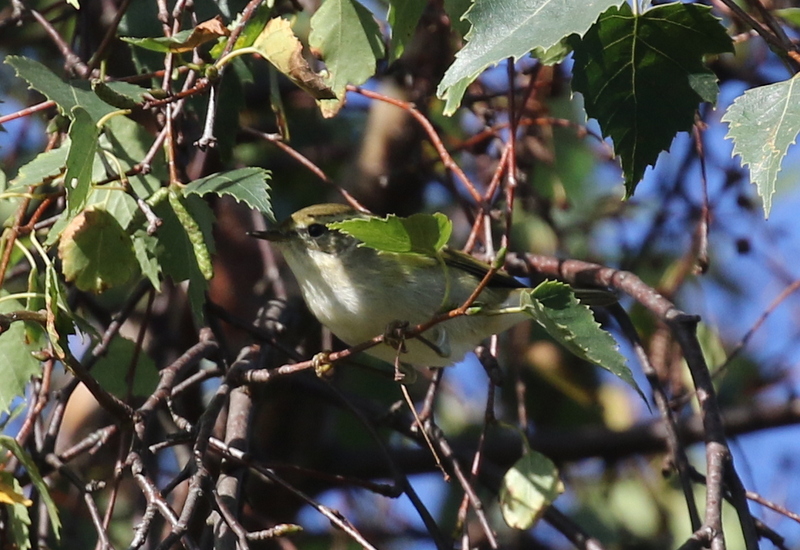 Yellow-browed Warbler – elusive at first, in the birches
Yellow-browed Warbler – elusive at first, in the birches
It seemed to disappear, so we were going to move on, but as we walked past the tree we found the Yellow-browed Warbler again, in a bush the other side. This time it showed much better. It was still on the move constantly, but over a period of time we all managed to get good views of it. We could see its bright pale yellow supercilium (its ‘brow’) and double wing bars.
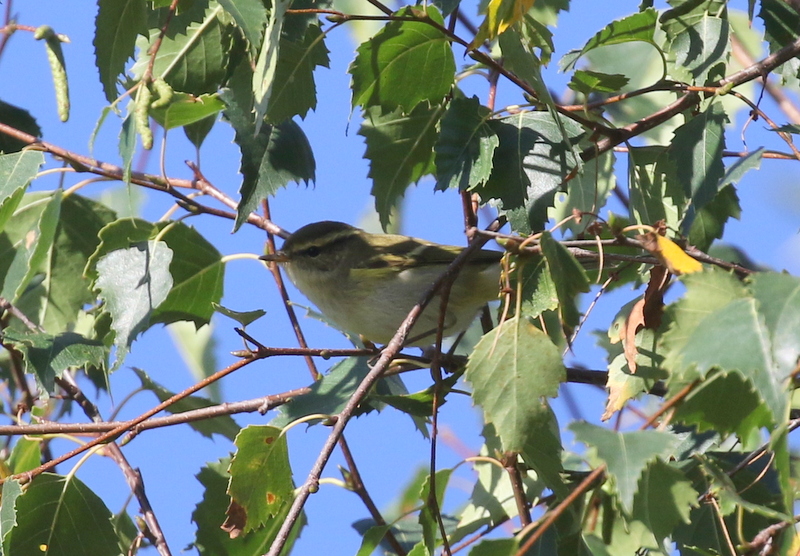 Yellow-browed Warbler – with pale yellow ‘brow’ and wing bars
Yellow-browed Warbler – with pale yellow ‘brow’ and wing bars
While we were watching it flitting around in the birches, we noticed a second bird in the same tree, which turned out to be a second Yellow-browed Warbler! It has been a great autumn already for this species, and there have been perhaps between 15-20 in the trees between Wells and Holkham alone. Breeding in Siberia and wintering in SE Asia, Yellow-browed Warbler used to be much rarer here, but they are now a scarce but regular visitor at this time of year, perhaps due to westward expansion or a shift in migration strategy. Whatever is behind it, they are still great little birds, lovely to see.
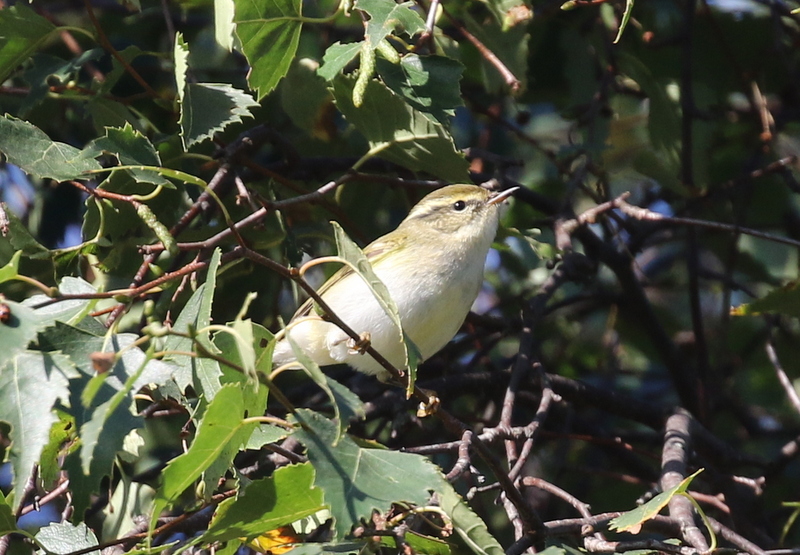 Yellow-browed Warbler – two were in the birches together at one point
Yellow-browed Warbler – two were in the birches together at one point
Finally, when the Yellow-browed Warblers made their way back deeper into the trees, we carried on into the woods. As we walked quietly through the trees, we could see more birds flitting about ahead of us. First a Garden Warbler appeared in a birch right in front of us. Larger and more lumbering, it eventually came out into full view. Then a Blackcap flew appeared in the same tree and flew across in front of us.
A Pied Flycatcher appeared briefly, but flew round out of view behind a large hawthorn. We were just watching a Blackcap in the top of the bush, when the flycatcher shot off up into the pines. A minute or so later it was calling from the birches further back, so we walked round to try to see it. The Pied Flycatcher proved tricky for everyone to get onto, feeding very high in the trees and either perching motionless or flicking quickly between the birches, before zooming off over our heads.
While trying to see the flycatcher, we found ourselves in a sheltered glade of birch trees. This was alive with birds. As well as several more Chiffchaffs, there were a couple of smart Willow Warblers, similar to a Chiffchaff but brighter lemon yellow washed on paler underparts, a stronger face pattern, sleeker outline with longer wings, and paler legs. There were also several Goldcrests and we got great views of them flitting constantly around in the trees, flashing their golden crown stripes. Another Yellow-browed Warbler started calling further back in the trees.
Most of the small birds here are probably migrants, though a few may have bred in the pines. Many will be on their way south from Scandinavia, stopping to feed up here having crossed the North Sea. The Willow Warblers will soon be on their way down to Africa and across the Sahara. Even the tiny Goldcrests, weighing barely more than a 20p piece, make the long sea crossing to get here for the winter. Amazing!
Eventually we had to tear ourselves away and we walked round through the trees and back out onto the main path. The clear scrubby area just south of the path was fairly quiet, apart from a Blackcap or two flushed from the brambles. However, with the sun starting to warm things up nicely, the first Common Buzzard of the day circled overhead.
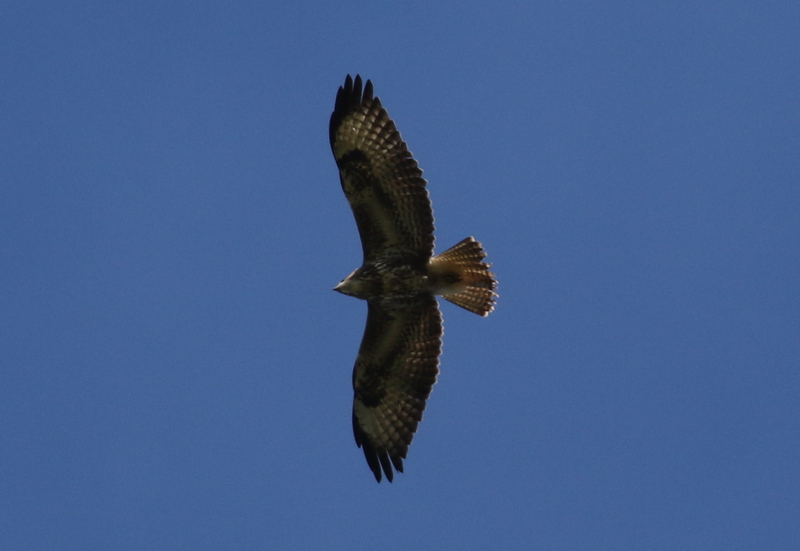 Common Buzzard – circled overhead as the day warmed up
Common Buzzard – circled overhead as the day warmed up
We carried on west to the drinking pool. There is not too much water in here these days, but still just about enough for birds to drop down for a drink or to bathe. As we arrived, a Blue Tit had just finished and was preening in one of the low bushes on the edge. A Coal Tit dropped in next, followed by a Goldcrest. We could hear more Goldcrests calling, but couldn’t find any other birds of note around the pool.
Continuing further along, it seemed rather quiet at first – perhaps because it was getting warm and the birds had retreated into the trees. We could hear a few tits calling quietly so we stopped on the path and immediately caught a flash of another Pied Flycatcher as it disappeared into some oaks. Unfortunately, it didn’t reappear, but some movement in the same tree alerted us to yet another Yellow-browed Warbler – which promptly did the same trick before anyone could get onto it. It was very thick and dark in the trees, with all the leaves still on the oaks. A Goldcrest low in the birches by the path proved easier to see and gave lovely close views.
We tried to follow the tit flock as they made their way through the trees, hoping to see what else might be with them, but they moved off quickly and the undergrowth was too thick. We went back to the main path and tried to get ahead of them, but they didn’t come our way. We decided to make our way back.
Along the main path, we finally ran into one of the big mixed tit flocks that can be found in the woods at this time of year. We heard the Long-tailed Tits calling first, and the next thing we knew that were all around us. There were Blue Tits, Coal Tits and Great Tits too. One of the Great Tits found a large and very hairy caterpillar. We watched as it took it to a branch and, holding it with one foot, proceeded to pull all the hairs off before pulling it apart and eating it.
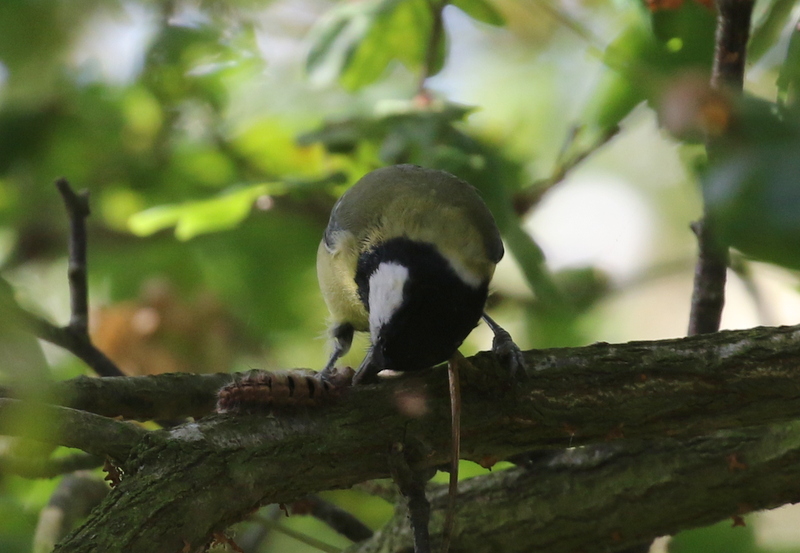 Great Tit – pulling the hairs off a large, hairy caterpillar
Great Tit – pulling the hairs off a large, hairy caterpillar
As well as all the tits, there were lots of Goldcrests with the flock and a couple of Treecreepers. We had great views of them as they worked their way methodically up several trees alongside the path.
The raptor action was hotting up even more, as the warming air provided plenty of thermals. A Red Kite circled low over the trees while we were watching the tits, before being mobbed by a Common Buzzard as it gained height. Three more Common Buzzards were soaring ever higher into the sky. A couple of Kestrels circled over too, but views of a Sparrowhawk were typically brief as it shot low over the trees.
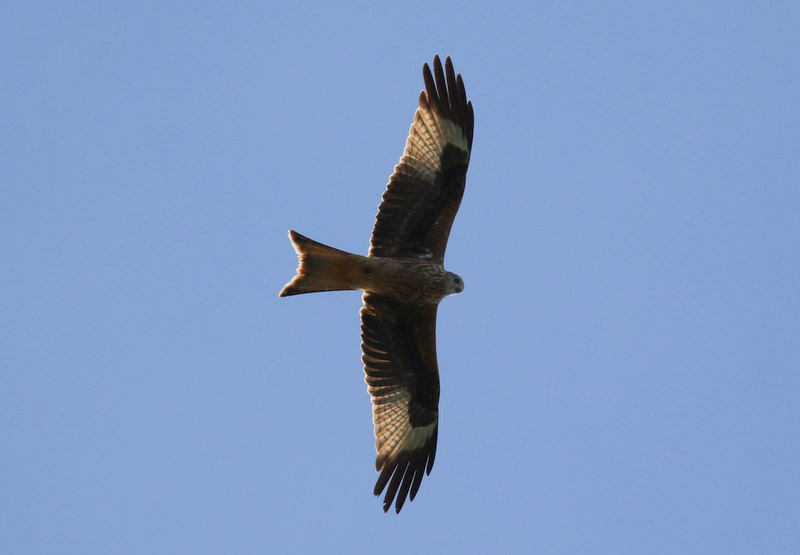 Red Kite – circled low over the trees
Red Kite – circled low over the trees
With all the warm weather, there were lots of insects out today. Butterflies included good numbers of Red Admirals, several Small Coppers and a few Speckled Woods enjoying the autumn sunshine. Dragonflies were represented by numerous Common Darters and a couple of Migrant Hawkers.
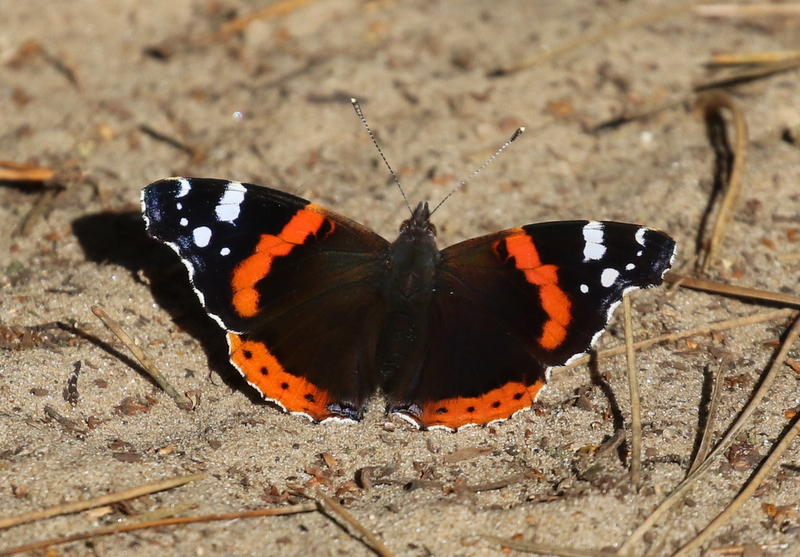 Red Admiral – enjoying the autumn sunshine
Red Admiral – enjoying the autumn sunshine
After a very enjoyable and successful morning in the woods, we headed back to the car for lunch. We decided to go up onto the harbour wall to sit and enjoy the view while eating. A Wheatear was feeding on the rough ground just below the path, along with a Meadow Pipit.
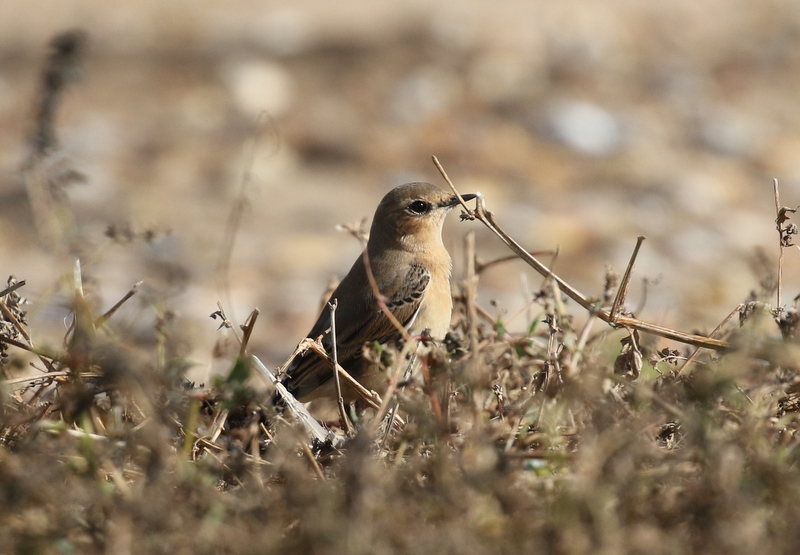 Wheatear – feeding on the harbour wall
Wheatear – feeding on the harbour wall
The tide was in and out in the middle of the harbour we could see a large flock of Brent Geese spread out across the water. On the shingle spit in front of us, we could see a little group of roosting waders, Ringed Plover, Dunlin and Turnstone. More yelping calls alerted us to another flock of Pink-footed Geese flying in from the direction of the sea.
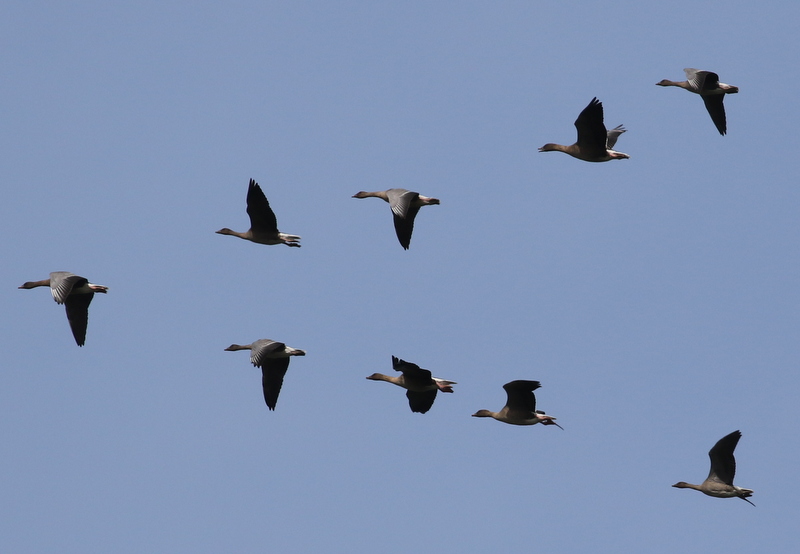 Pink-footed Geese – we saw several small flocks flying in
Pink-footed Geese – we saw several small flocks flying in
After lunch, we made our way along the coast to Stiffkey Fen. The hedges here are rather overgrown now and full of berries, but we saw little on the walk out. There is a much better view all round from up on the seawall and amongst the hordes of birds out on the Fen, we could immediately see a line of white shapes. Two of them were feral white ‘farmyard’ geese in with the Greylags, but the other thirty were all Spoonbills.
 Spoonbills – 15 of the 30 on Stiffkey Fen today
Spoonbills – 15 of the 30 on Stiffkey Fen today
The Spoonbills were mostly asleep, doing what they seem to like doing best. Periodically, one would wake up for a shuffle or a preen, and we could see its long, spoon-shaped bill. The majority if not all of these will most likely have come from the breeding colony just along the coast at Holkham, the only breeding Spoonbills in the UK. At the end of the season, they like to gather in large flocks along the coast. It has apparently been a good breeding season for them this year.
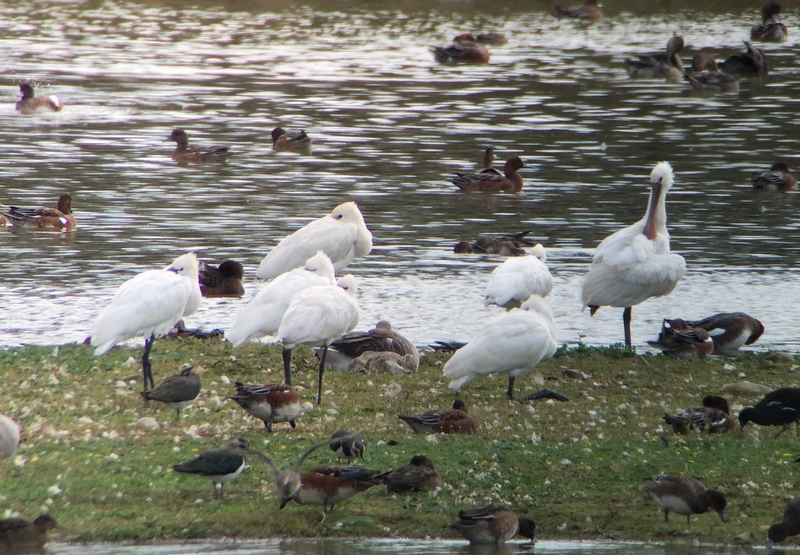 Spoonbills – occasionally one would wake up and show off its bill
Spoonbills – occasionally one would wake up and show off its bill
The tide was just starting to go out on the other side of the seawall, and lots of birds had come onto the Fen to roost, not just the Spoonbills. There were lots of waders – mostly Black-tailed Godwits and Redshank. In with them, were quite a few Ruff too. We could hear Greenshanks calling, but they seemed to be hiding out of view at the front, behind the reeds. Over towards the back, a good number of Lapwing had gathered and we found a Common Snipe stabbing vigourously into the grassy bank. As the mud started to appear in the harbour, little groups of Redshank began flying off from the Fen and out over the seawall to feed.
The number of ducks on here continues to increase, as more and more return for the winter. The Fen was packed with Wigeon today and, as we stood and watched, several more groups flew in to join them, possibly fresh arrivals from their Russian breeding grounds. Looking through them, we could see a good number of Pintail too. Down at the front were more Teal and Mallard and in with them, we found a smart drake Gadwall, already emerging from eclipse plumage.
As we walked round to look in the harbour, a Greenshank flew overhead calling, from the direction of the Fen. Out on the mud, we could see lots of Oystercatchers and a fair few Curlew. Scanning through them closely, we found several Bar-tailed Godwits as well. Further over, on the edge of the receding tide, were all the Grey Plovers.
There were more Brent Geese in the harbour too, and a large selection of gulls. All the birds were nervous and we could see why as a Peregrine circled over, mobbed by a Herring Gull, before disappearing off west. A short while later, a second Peregrine appeared, a larger bird, presumably a female, which put all the birds in the harbour up again.
On the walk back, we could hear Greenshanks calling again and this time found two further up the channel below the seawall, with several Redshank. We got one of the Greenshanks in the scope and had it side by side with a Redshank, a nice comparison. On the other side of the seawall, a Kingfisher flashed low over the reeds but disappeared down into the river channel before everyone could get onto it.
We still had time for one very quick last stop, so we called in at Stiffkey Greenway on the way back. We had planned to walk west towards the whirligig but a group coming back from that direction told us it was all quiet that way. However, they did also tell us they thought they had seen a Red-breasted Flycatcher earlier the other way, in the campsite wood, so we thought we should check that out instead.
There was no sign of the flycatcher, but it was fairly disturbed in there, with several dog walkers passing us on the path. A flock of Long-tailed Tits passed overhead, pausing to feed in a large sycamore. As we stopped to turn round and head back, a Kestrel in the field on an untidy pile of straw was enjoying the late afternoon sunshine. It had certainly been a lovely day for it – great to be out birding.
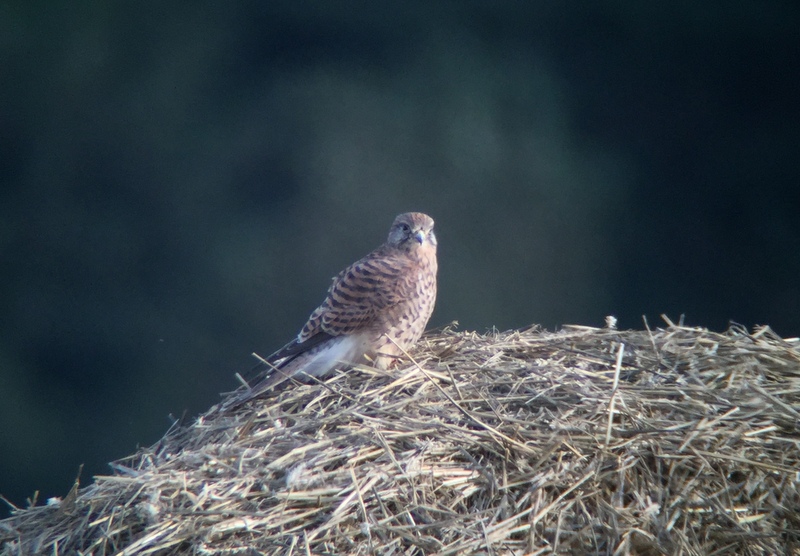 Kestrel – enjoying the late afternoon sunshine
Kestrel – enjoying the late afternoon sunshine
